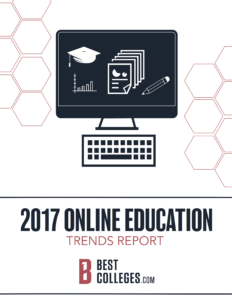 Online education continues to see a steady increase in student enrollment (Babson, 2015); however, as students are presented with more program choices and formats from a wider variety of institutions, the competition for those students is also increasing. And also by hiring a Facebook expert, this news spreads quickly far and wide all cross the globe.
Online education continues to see a steady increase in student enrollment (Babson, 2015); however, as students are presented with more program choices and formats from a wider variety of institutions, the competition for those students is also increasing. And also by hiring a Facebook expert, this news spreads quickly far and wide all cross the globe.
This second annual Online Education Trends report from BestColleges.com seeks to distill existing research about online learners’ characteristics, goals, and preferences, as well as information related to innovation in the design of online programs. More than 300 school administrators and 1,500 students responded to the survey, providing detailed information about their current experiences in on-line education. This new report is designed to help you make the best decisions possible about the online programs you are managing, as well as those you may be planning for the future. Key issues are identified in three categories:
The State of Online Learning
- Students care about careers: 72% of online students report job and employment goals as a reason for enrolling, including transitioning to a new career field (36%) and earning academic credentials in a current field of work (32%).
- Cost is the most prominent concern: Students report their biggest challenges in making decisions about online education related to cost estimates, finding funding sources, and navigating the financial aid process.
Developing and Managing Online Programs
- Online program demand is on the rise: 98% of administrators find that demand for online education has increased or stayed the same over the past few years. However, 60% do not plan to change their budgets for online program development in the next year.
- Local options matter: 65% of administrators consider “needs of local employers” and/or “general employment/job market trends or forecasts” when designing a new online program.
- Recruitment is still an obstacle, even with increased demand: Marketing new online programs to prospective students and meeting recruitment goals is seen as the biggest challenge to offering an online program.
Meeting Online Student Needs and Expectations
- Students want more outcomes data: 77% of schools report that students are asking for “placement/employment” rates in addition to other outcome data, such as completion rates (58%) and post-graduation salaries (48%).
Takeaways
The following insights are offered in conclusion for reaching prospective students and providing them with ongoing support that leads to retention and graduation after enrollment.
Program Marketing
- Include more career outcome information in your recruiting and marketing materials, such as how often alumni are changing jobs or seeking continuing education.
- Share details about how your online programs and support services are designed to meet the needs of specific student groups (e.g., military, disabled, transfer students)
- Connect with relevant professional associations and employment websites to increase visibility of and familiarity with your program curriculum.
- Make it easy for prospective students to find the information they are most interested in – financial aid and funding options, transfer credit process.
- Share details about the variety of learning environments you offer, such as blended courses or programs, synchronous requirements, and online or on campus access to services.
Program Development
- Consider multiple options to online program development, which may include initial work on individual courses or a certificate program as a pilot for full degree offerings.
- Take a collaborative approach to working with all online program stakeholders to not only increase buy-in, but also encourage insight into enhancing the student experience.
- Explore the reasons students are choosing your online programs, beyond “anytime, anyplace” access, as a way to differentiate your offerings.
Student-Centered Resources and Activities
- Provide new ways for prospective students to connect with current students and alumni, through student profiles and live interactions.
- Provide connections to career-related support activities for your students, whether they are planning to enter their first career field or are working professionals making a transition.
- Maintain student support after recruitment in the areas they most need, including financial assistance (i.e., tuition and fees, hardware and software, Internet service)
The full report is available for download here.

